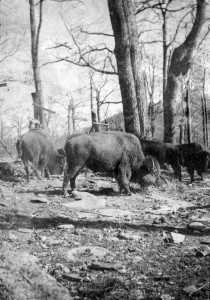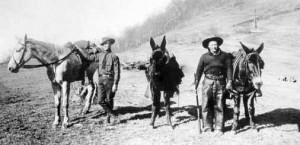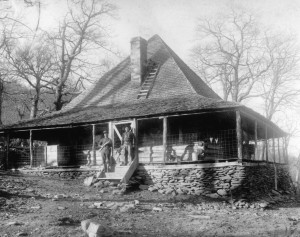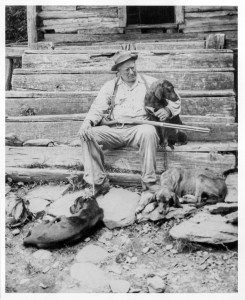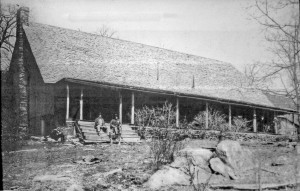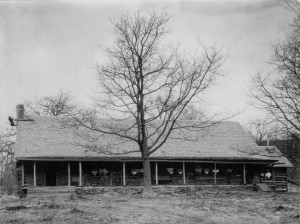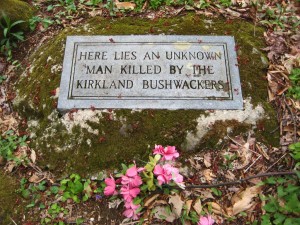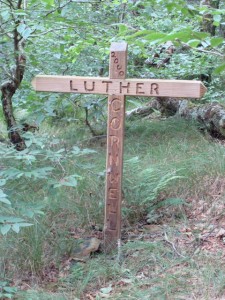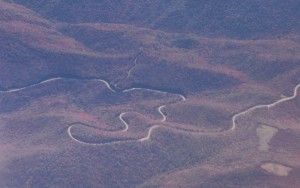
History of the Cherohala Skyway, including Hooper Bald Lodge and the Russian Blue Boar, Tellico Wagon Train, Kirkland Bushwackers. The dream of the Cherohala Skyway began in 1958. Television was America’s new brand of entertainment and wild westerns were a Hollywood staple. Gunsmoke and Wagon Train captured weekly audiences. Wagon Train, dramatizing the settling of the American frontier, was a favorite show of Sam Williams. Williams dreamed of leading his own wagon train from his home in Tellico Plains to the Unakas of North Carolina. He brought up his idea, jokingly, at the Kiwanis Club meeting in the spring of 1958. There were roads that joined the two locations but at the time were only fit for covered wagons. After some derisive laughter, the idea started to take a serious tone and the idea for a new Wagon Train Road was born.
Six weeks after the original idea, sixty-seven covered wagons and over three hundred horseback riders gathered at the Tennessee - North Carolina state line to make history. This first Wagon Train traveled to Murphy, North Carolina. The politicians loved the idea, which would evolve into the construction of a highway between Tellico Plains and Western North Carolina. The success of the first wagon train took the organizers by surprise. Promotion of the highway was important, but the experience of an authentic wagon train was the reason it became an annual event.Efforts to assure the construction of a highway from Tellico Plains to Western North Carolina took a turn in late 1962. The original route from Tellico Plains to Murphy was not feasible. It was discovered that a highway could be built between Tellico Plains and Robbinsville entirely on federal land. Robbinsville was the only Western North Carolina town to which such a route was possible. Late in 1962, Congress made the first allocation for the new highway.After 100 million dollars and thirty-four years, the Cherohala Skyway was official opened in October 1996. At that time the US Forest service estimated that five million cars a year would use the new road. This figure, which calculates to 10 cars a minute year-round, was extremely unrealistic. The actual figure today is more like an average fifty cars and a hundred motorcycles a day.The Skyway is beautiful but desolate most of the winter months. It can be dangerous with icy conditions and deep snow.
GRAVES ON THE CHEROHALA SKYWAY
Nine USAF crew members lost their lives near the summit (4908 feet) of Johns Knob on the Tennessee/North Carolina border on August 31, 1982. The C141 transport airplane was on a training mission practicing low level terrain radar avoidance tactics. All crew members were lost. It is unclear if any remains were found, but the crash was so intense that only small pieces of wreckage scattered over a half mile from the summit were recovered. No markers.
Two surveyors were found frozen to death near Huckleberry Knob and are buried near the summit.
Early settler Absolum Stratton is buried at the Tennessee/North Carolina State Line at Stratton Gap. Grave stone at west side of bridge.
Unknown man killed by Kirkland Bushwackers is buried near Stratton Gap. Marker in ground.
HOOPER BALD AND THE BLUE BOAR
In 1908 the Whiting Manufacturing Company of England purchased a large tract of land in the Snowbird Mountains of Graham County, North Carolina. Mr. George Gordon Moore, an advisor for the company, was allowed to establish a game reserve on Whiting lands. About 1911 a 500-acre hog lot enclosed by split rail fencing was constructed on Hooper Bald, a 5,400-foot mountain near the Tennessee line.
In April 1912 a shipment of European wild hogs arrived in Murphy by rail. The eleven sows and three boars, purchased from an agent in Berlin, Germany, were said to have come from the Ural Mountains of Russia. Each of the hogs weighed between 60 and 75 pounds. One of the sows died during the rugged transport from Murphy to Hooper Bald by ox-drawn wagon. The journey was remarkable in the vast wilderness of the day.
From the beginning the hogs were able to escape the pen. A number were known to have rooted-out passages under the fence so they could come and go at will. The relocated animals found the extreme conditions favorable and immediately began to proliferate. In the early 1920s the population in the lot was estimated at 100 hogs, but many others were living free. A hunt with dogs was conducted in the pen and only two hogs were killed - the rest escaped in the frenzy, joining those already living in the dense mountain wilderness.
Today the Russian Blue Boar population continues to grow in spite of hunting and the encroachment of civilization. A typical two-year-old male hog can weigh 180 pounds, but much larger boars have been taken. Now you can visit Hooper Bald in the luxury of your vehicle after a twenty-minute drive on the Cherohala Skyway. It is hard to imagine that an ox-drawn wagon could have ever made it to the top. An encounter with a wild hog is unlikely for the typical visitor. These animals tend to stay in the deepest forests.
BOB STRATTON BALD AND STRATTON MEADOW
Absolum (AB) Strutton/Stratton was born in 1772 in North Wilkesboro, Wilkes County, North Carolina and died August 8, 1852 probably in Tennessee. He married Darcus Shearman on October 25, 1806 in Wilkes County. According to a story related by a Stratton researcher, Absolum was visiting his son John who "lived at Stratton Meadow, in a big two-story log house about 200 yards inside Tennessee. Absolum got sick and he and others in the family knew he was going to die. Since he did not fear death, they discussed it freely. John and some of his sons cut a large tree and from it they hewed a coffin. Ablsoum said he liked Tennessee and North Carolina equally well and wanted to be buried in both states. They buried him astride the line, with his head in Carolina and his feet in TN."
JOHN STRUTTON was born October 11, 1799 in North Carolina and died July 9, 1862 in Tennessee. He married Alydia Clark who was born January 18, 1795 in North Carolina and died November 9, 1874 in Tennessee. They were married April 16, 1820. John was a captain in the Blount County Militia and participated in the Cherokee removal circa 1839.
Excerpted from History of Western North Carolina - County History - John and Robert Stratton came from Monroe County, Tennessee in the thirties and settled on the Unaka Mountains between the head of the Sassafras Ridge and Santeetla Creek. John lived on the John Stratton Bald ten years and caught 19 panthers on the Laurel Top, making "bacon" of their hams and shoulders. He came with nothing but his rifle, blanket, skillet and ammunition, but made enough herding cattle and selling deer and bear hams and hides, etc., to buy a fine farm in Monroe County, Tennessee.
ROBERT STRUTTON was born 1825 in Blount County, TN, and died September 4, 1864 in Graham County, North Carolina - Jenkins/Santeetlah Baptist Church Cemetery. He married NARCISSUS NICHOLS May 25, 1845 in Blount County, Tennessee (Source: Family Tree Archives CD #229). He served in the 59th Tennessee Infantry Regiment, Company G, CSA. According to records found by a Stratton researcher, Robert moved a few miles from his father's place to a spot still called Bob Bald and built a rude hut with a chimney. He lived there with his wife Narcissus and eight children. On September 2, 1864, he set out to hunt a stray cow. He carried a new rifle and Jackson Roberts went with him. As they came down the road through Ball Play community in Monroe County, Stratton noticed a paper in the road. It was a trap. As he leaned over to pick it up the Kirkland Bushwhackers killed him with a volley of shots that also wounded Roberts. Roberts hid in a pile of wood, the bushwhackers took Bob's new rifle and left Roberts who died two days later.
Information provided by Cory D. Mills: Visit Cory's Genealogy Site
KIRKLAND BUSHWACKERS
BUSHWHACKERS ONCE ROAMED GRAHAM COUNTY
By Marshall McClung, Contributing Writer to the Graham Star
The Civil War had a fascinating impact on Graham County as well as the rest of western North Carolina and nearby areas of east Tennessee. North Carolina, well known for its loyalty to the homeland, comprised one fifth of the Confederate Army. But not all citizens were loyal to the Confederate Army, especially in the mountain area. There were many reasons for this. Much of the mountain residents were of Scotch-Irish descent, and of a very independent nature. They did not want anyone, Union or Confederate telling them who they should fight or serve. It was not all that long since they had gained their Independence from the British, and did not want to risk losing it again. As a result, many found themselves to be considered enemies of both sides. Graham County, which was a part of Cherokee County until 1872, had far more trouble from bushwhackers and renegades than it did from either Union or Confederate soldiers.
One tragic event happened in the Goldmine Branch- Rock Creek area. Two young boys, John Stratton, 17, and another teenaged boy, Tom Mashburn were hiding out in the woods near the Old Tallassee Trail (also called the Belding Trail, Hudson Trail, and Dave Orr Trail). They were attempting to avoid a Confederate Conscript office that was in the area searching for young men for soldiers. Both the Union and Confederate Army used conscription methods (forced enlistment) as the need for more soldiers increased. They were hiding in an area known as the Rufus Stand close to Sarah Rhodes Branch and what was later known as the Odom Fields. Captain Tim Lyons along with members of Company C, Third Tennessee Mounted Calvary, USA was also in the area. Lyons, a one-eyed native of Ireland, had deserted from the Union Army, and his command at this time was made up mostly of Confederate deserters, bushwhackers, robbers, old men, and young boys. The date was October 3, 1864. The group came upon Stratton and Mashburn who attempted to flee, but were shot and killed on the spot.
The boys were wrapped in a sheet and buried in a single grave by Avaline Stratton and Eliza Carringer. The women labored most of the day digging the grave, as they only had crude tools to dig with. The softest earth was in the front yard near the log house, so they buried the boys there, possibly marking the site with a few small stones.
The grave was located by Frank Howell and Robert Barker in August 1960. Mrs. Frank Howell gave them directions to the grave. She had hoed corn in a field near the grave and recalled seeing it. Her father William Riley Phillips was present when the boys were buried. He was around six or eight years old at the time. The head stone in the photograph accompanying this story was placed at the grave on July 27, 1962, and was carried into the area by unknown volunteers from the Goldmine Branch area.
I was unable to discover any more information about Tom Mashburn, but a considerable amount about John Stratton. John was the son of Robert R. and Narcissus Stratton who lived near Bob Creek in an area now known as Swan Meadows. Bob Creek and Bob Stratton Bald or Stratton Bald was named for Bob Stratton. Stratton Meadows near the Cherohala Skyway was named for his father, the original John Stratton. Robert, or Bob Stratton, the father of the young John Stratton listed above, was also killed by bushwhackers in the same year about a month earlier. He was killed September 2, 1864 near Ball Play in Monroe County Tennessee, while hunting for cows. He was accompanied by Jack Roberts. The men saw a piece of paper lying in the road, and bent over to pick it up. It was an ambush set in place by the Kirkland Bushwhackers. It was said that the main reason for the ambush was to get a new breech-loading Spencer rifle Stratton was carrying. The Kirkland gang killed Stratton and wounded Roberts, who managed to hide, but died from his wounds two days later. Stratton was buried in the bank of the road near where he was killed. Roberts is buried in the Old Rafter Cemetery near Ball Play, Tennessee. Narcissus Stratton, mother of John Stratton, and husband of Bob Stratton, is buried in the Santeetlah Cemetery in Graham County. She lived until 1887.
Tim Lyons and his notorious bunch, sometime after killing the boys, went to Valleytown (now Andrews), stole cows belonging to Isaac Hamilton, and killed him. Sometime later, back in what is now Graham County; they killed one of the Kirkland Bushwhackers, Jesse Kirkland, Jr. as he was throwing chestnuts into the lap of his girlfriend. This was near Stump Ford (Ground Squirrel Branch-Cross Creek area). The Kirkland gang had a hideout below the present location of Horse Cove Campground near Avey Branch on lower Santeetlah Creek.
Lyons and his group apparently moved back into Cherokee County on April 26, 1865 and burned the Cherokee County Courthouse in Murphy to the ground.
It was a tough situation that our mountain residents found themselves in in those days. It was difficult to be neutral, and gangs like Captain Lyons’s and the Kirkland Bushwhackers didn’t care which side you favored, since they favored neither side themselves, but took advantage of easy pickings.
Bushwhackers and renegades roamed throughout the mountains of Graham County, but their favorite ambush spots were said to be the Slickrock area, especially Big Fat Gap, Stratton Meadows, and Deals Gap at the North Carolina/Tennessee state line.

